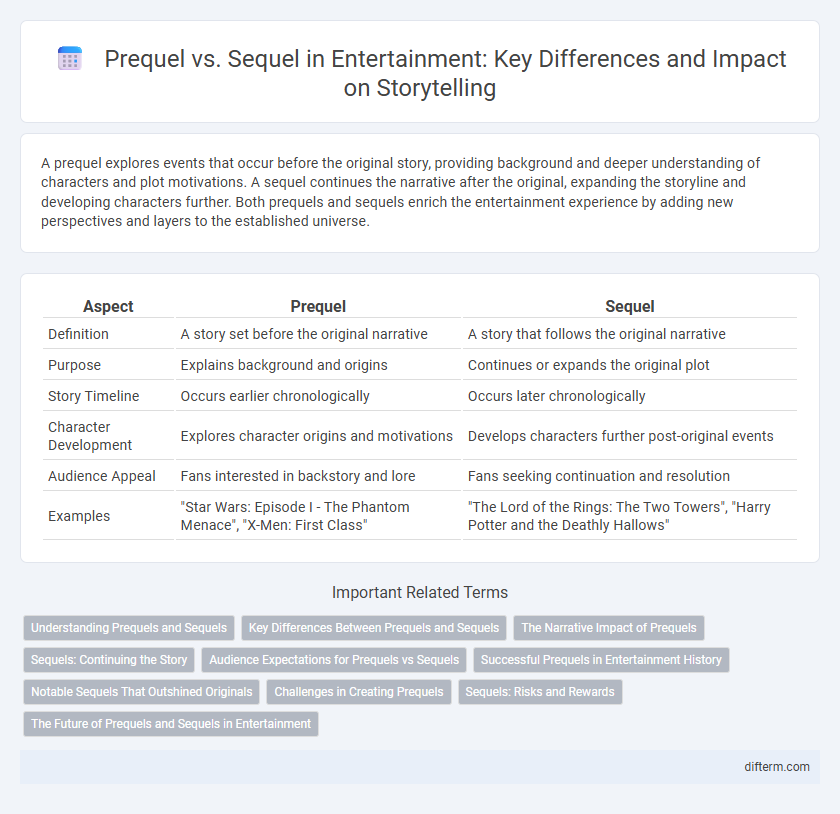A prequel explores events that occur before the original story, providing background and deeper understanding of characters and plot motivations. A sequel continues the narrative after the original, expanding the storyline and developing characters further. Both prequels and sequels enrich the entertainment experience by adding new perspectives and layers to the established universe.
Table of Comparison
| Aspect | Prequel | Sequel |
|---|---|---|
| Definition | A story set before the original narrative | A story that follows the original narrative |
| Purpose | Explains background and origins | Continues or expands the original plot |
| Story Timeline | Occurs earlier chronologically | Occurs later chronologically |
| Character Development | Explores character origins and motivations | Develops characters further post-original events |
| Audience Appeal | Fans interested in backstory and lore | Fans seeking continuation and resolution |
| Examples | "Star Wars: Episode I - The Phantom Menace", "X-Men: First Class" | "The Lord of the Rings: The Two Towers", "Harry Potter and the Deathly Hallows" |
Understanding Prequels and Sequels
Prequels explore events that occur before the original storyline, providing background and deeper character motivations, while sequels continue the narrative, advancing the plot and character development beyond the initial conclusion. Understanding the difference between prequels and sequels is essential for grasping how franchises maintain audience engagement and expand their fictional universes. Both forms enrich storytelling by either filling gaps in the original story or progressing its timeline.
Key Differences Between Prequels and Sequels
Prequels explore events that occur before the original narrative, providing background and context to character origins and story development. Sequels continue the storyline after the original, advancing characters' arcs and unresolved plotlines. Understanding these distinctions enhances appreciation of franchise storytelling and audience engagement.
The Narrative Impact of Prequels
Prequels enhance narrative depth by exploring characters' origins and motivations, providing context that enriches the original storyline. This backward storytelling technique allows audiences to understand pivotal events and character development more profoundly, increasing emotional engagement. By filling in gaps and unraveling mysteries, prequels create a layered narrative structure that complements and complicates the sequel's plot progression.
Sequels: Continuing the Story
Sequels extend the narrative established in the original film, delving deeper into character development and expanding the story universe to maintain audience engagement. They often introduce new conflicts and challenges while preserving the thematic elements that defined the initial installment. By building on established plotlines, sequels drive franchise growth and enhance fan loyalty through continuity and evolving storytelling.
Audience Expectations for Prequels vs Sequels
Prequels often generate audience curiosity by exploring backstories and origins, enriching the existing narrative with deeper character motivations. Sequels typically raise expectations for plot progression, new conflicts, and expanded world-building that build on previous events. Fans anticipate prequels to provide meaningful context, while sequels are expected to deliver future developments and satisfy ongoing story arcs.
Successful Prequels in Entertainment History
Successful prequels like "Star Wars: Episode I - The Phantom Menace" and "The Godfather Part II" expanded beloved narratives by exploring character origins and backstory, often enriching the original story's depth. Prequels that achieve critical and commercial success typically balance nostalgic elements with fresh storytelling, attracting both existing fans and new audiences. These films demonstrate that a well-crafted prequel can elevate a franchise by providing compelling context that complements and enhances the original storyline.
Notable Sequels That Outshined Originals
Notable sequels such as "The Godfather Part II" and "The Dark Knight" have surpassed their originals in critical acclaim and cultural impact, setting new benchmarks in storytelling and production quality. These sequels expanded on character development and complex narratives, elevating the franchise's legacy and deepening audience engagement. The commercial success and lasting popularity of these films demonstrate how sequels can redefine and enhance the original cinematic experience.
Challenges in Creating Prequels
Creating prequels presents unique challenges such as ensuring continuity with the original storyline while introducing fresh elements that engage the audience. Writers must carefully navigate established character backstories and plot outcomes to avoid contradictions or plot holes. Balancing fan expectations with creative innovation demands meticulous attention to narrative coherence and character development.
Sequels: Risks and Rewards
Sequels carry the risk of disappointing audiences if they fail to meet or exceed the original film's quality, but they often reward studios with increased box office revenue and franchise longevity. Successful sequels leverage established characters and storylines while introducing fresh elements to maintain viewer interest and critical acclaim. Despite the challenges, iconic sequels like "The Godfather Part II" and "The Dark Knight" demonstrate the potential for surpassing originals and solidifying cultural impact.
The Future of Prequels and Sequels in Entertainment
Prequels and sequels continue to dominate entertainment by expanding beloved narratives and deepening character backstories or future arcs, driving audience engagement. Streaming platforms and advanced CGI technology enable creators to produce high-quality prequels and sequels with immersive storytelling and visual effects unmatched in previous decades. Trends indicate a growing preference for interconnected cinematic universes, blending both prequel and sequel formats to create expansive, multi-layered entertainment experiences.
prequel vs sequel Infographic

 difterm.com
difterm.com